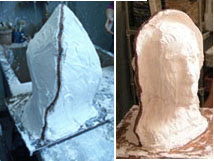
Thursday, March 29, 2007
Thursday, March 22, 2007
Do The Greats Do These Bits?
I wonder. Hmmm. The clay mould set hard, then had to be prised apart, then carefully scrubbed clean. It took ages to get the little bits of clay out of every nook and cranny. Then the whole thing needed basting with engine oil - seriously! All of that took 2 sessions - 5 hours; Henry Moore eat your heart out. Apparently he just made everything in polystyrene or found an interesting stone and then told some workmen to replicate. One day, one day ... anyway here is the oiled mould:


Thursday, March 15, 2007
Plaster Mould
Thursday, March 08, 2007
Shimming

A plaster mould will next be made from the clay model. This mould needs to be in 2 sections and to achieve this, a barrier of metal "shims" is created through the middle of the model. I had to use cut up pieces of old beer cans. These need to fit very snugly together to prevent any plaster bleeding through the divide. An edge of clay is added to act as a clear marker once plaster is added.
Subscribe to:
Posts (Atom)
